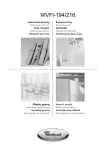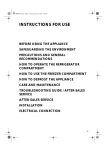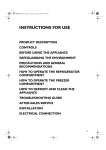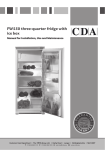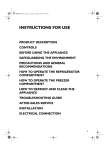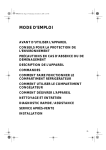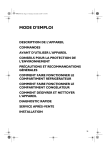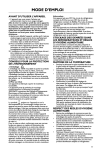Download Whirlpool ARC 1872 IX Troubleshooting guide
Transcript
33502002GB.fm Page 74 Thursday, March 22, 2007 11:54 AM INSTRUCTIONS FOR USE BEFORE USING THE APPLIANCE SAFEGUARDING THE ENVIRONMENT PRECAUTIONS AND GENERAL RECOMMENDATIONS HOW TO OPERATE THE REFRIGERATOR COMPARTMENT HOW TO OPERATE THE LOW TEMPERATURE COMPARTMENT HOW TO DEFROST AND CLEAN THE REFRIGERATOR CLEANING AND MAINTENANCE TROUBLESHOOTING GUIDE AFTER-SALES SERVICE INSTALLATION ELECTRICAL CONNECTION 74 Downloaded from Fridge-Manual.com Manuals 33502002GB.fm Page 75 Thursday, March 22, 2007 11:54 AM BEFORE USING THE APPLIANCE • Your new appliance is designed exclusively for domestic use. For best use of your appliance, carefully read the user handbook which contains a description of the appliance and advice on storing and preserving food. Keep this handbook for future consultation. 1. After unpacking the appliance, make sure that it is undamaged and that the doors close correctly. Any damage must be reported to the dealer within 24 hours of delivery of the appliance. 2. Wait at least two hours before switching the appliance on, to ensure that the refrigerant circuit is fully efficient. 3. Installation and the electrical connection must be carried out by a qualified technician, according to the manufacturer's instructions and local safety regulations. 4. Clean the inside of the appliance before using it. SAFEGUARDING THE ENVIRONMENT 1. Packaging The packaging material is 100% recyclable and carries the recycling symbol. For disposal, comply with the local regulations. Keep packing materials (plastic bags, polystyrene parts, etc.) out of the reach of children, as they are a potential source of danger. 2. Scrapping/Disposal The appliance is manufactured using recyclable material. This appliance is marked according to the European directive 2002/96/EC on Waste Electrical and Electronic Equipment (WEEE). By ensuring that this appliance is disposed of correctly, you are helping to prevent potentially damaging consequences for the environment and for human health. The symbol on the appliance, or on the accompanying documents, indicates that this appliance should not be treated as domestic waste but must be taken to a special collection centre for the recycling of electrical and electronic equipment. When scrapping the appliance, make it unusable by cutting off the power cable and removing the doors and shelves so that children cannot easily climb inside and become trapped. Scrap the appliance in compliance with local regulations on waste disposal, taking it to a special collection centre; do not leave the appliance unattended even for a few days, since it is a potential source of danger for children. For further information on the treatment, recovery and recycling of this product, contact your competent local office, the household waste collection service or the shop where you purchased the appliance. Information: This appliance does not contain CFCs. The refrigerant circuit contains R134a (HFCs) or R600a (HCs), see the rating plate inside the appliance. Appliances with isobutane (R600a): Isobutane is a natural gas of low environmental impact. Caution is required, however, since isobutane is flammable. Therefore, ensure that refrigerant circuit pipelines are not damaged Declaration of conformity • This product has been designed for preserving food and is manufactured in compliance with Regulation (CE) No. 1935/2004. • This product has been designed, manufactured and marketed in compliance with: - the safety objectives prescribed in the Low Voltage Directive 2006/95/CE (which replaced Directive 73/23/CEE as amended). - the protection requirements of the “EMC” 89/336/CEE directive, amended by Directive 93/68/CEE. • Electrical safety of the appliance can only be guaranteed if it is correctly connected to an approved earthing system. 75 Downloaded from Fridge-Manual.com Manuals 33502002GB.fm Page 76 Thursday, March 22, 2007 11:54 AM PRECAUTIONS AND GENERAL RECOMMENDATIONS • During installation, make sure the appliance does not damage the power cable. • Make sure the appliance is not placed near a heat source. • To guarantee adequate ventilation, leave a space on both sides and above the appliance and follow the installation instructions. • Keep the appliance ventilation openings free. • Power cable modification or replacement must only be carried out by qualified personnel. • It must be possible to disconnect the appliance from the power supply by unplugging it or by means of a mains two-pole switch installed upstream of the socket. • Make sure the voltage specified on the rating plate corresponds to that of your home • For the water connection, use the pipe supplied with the new appliance; do not reuse the one from the previous appliance. • Install and level the appliance on a floor strong enough to take its weight and in a place suitable for its size and use. • The appliance must be handled and installed by two or more persons. • Be careful not to damage the floors when you move the appliance (e.g. parquet flooring). • Do not use single/multiple adapters or extension cords. • Install the appliance in a dry, well-ventilated place. The appliance has been configured for operation in places where the temperature falls within the following ranges, and within the climatic class given on the rating plate. The appliance may not work properly if it is left for a long time at a temperature outside the specified range. Climatic Class SN N ST T Amb. temp. (°C) From 10 to 32 From 16 to 32 From 16 to 38 From 16 to 43 76 Downloaded from Fridge-Manual.com Manuals Amb. temp. (°F) From 50 to 90 From 61 to 90 From 61 to 100 From 61 to 110 • Do not store or use petrol, flammable liquids or gas in the vicinity of this or other electrical appliances. The vapours may cause fire or explosion. • Do not use mechanical, electric or chemical means other than those recommended by the Manufacturer to speed up the defrost process. • Do not damage the appliance refrigerant circuit pipes. • Do not use or place electrical appliances inside the product if they are not of the type expressly authorised by the Manufacturer. • This appliance is not designed for use by young children or the infirm without supervision. • To avoid the risk of children becoming trapped and suffocating, do not allow them to play or hide inside the appliance. • Do not swallow the contents (non-toxic) of the ice packs (where provided). • Use the refrigerator compartment to store fresh food only and the freezer compartment to store frozen food, to freeze fresh food, and to make ice cubes only. • Do not store glass containers with liquids in the freezer since they may burst. • Do not eat ice cubes or ice lollies immediately after taking them out of the freezer since they may cause cold burns. • Before carrying out any maintenance or cleaning, unplug the appliance or disconnect it from the power supply. • All appliances equipped with an ice-maker and water dispenser must be connected to a water supply that only delivers drinking water (with mains water pressure of between 0.17 and 0.81 Mpascals (1.7 and 8.1 bar)). Ice-makers and/or water dispensers not directly connected to the water supply must be filled with drinking water only. • The Manufacturer declines any liability if the above advice and precautions are not respected. 33502002GB.fm Page 77 Thursday, March 22, 2007 11:54 AM HOW TO OPERATE THE REFRIGERATOR COMPARTMENT Starting the appliance up Starting up the appliance Depending on the model, the appliance has either external or internal controls. Plug in the appliance. For appliances with external controls: • The light, positioned either below the control panel or inside the appliance (depending on model) switches on when the door is opened. • Green LED lights up, indicating the appliance is running. For appliances with internal controls, when the appliance is connected to the mains, the inside light switches on when the refrigerator door is opened (as long as the thermostat knob is not turned to z. The thermostat, located inside the refrigerator compartment or on the front panel of the appliance, is used to adjust the temperature of both the refrigerator compartment and low temperature compartment (if fitted). Adjusting temperature 1. For correct operation and optimum storage of food, follow instructions given in the enclosed product sheet for thermostat adjustment. 2. To adjust the temperature in the compartment, turn the thermostat control knob: • to lower numbers 1-2/MIN for the LEAST COLD internal temperatures; • to 3-4/MED for a MEDIUM temperature; • to 5-7/MAX for the COLDEST temperature. Thermostat setting on z: no operation, no light. Note: • The ambient air temperature, frequency of door opening and the position of the appliance can affect internal temperatures. Take these factors into consideration when setting the thermostat knobs. 77 Downloaded from Fridge-Manual.com Manuals 33502002GB.fm Page 78 Thursday, March 22, 2007 11:54 AM How to store food in the refrigerator compartment Position the food as shown in the figure. A Cooked food B Fish, meat C Fruit and vegetables D Bottles E Cheese Attention: • The space between the shelves and the rear wall of the refrigerator compartment must be unobstructed to allow circulation of air. • Do not place food in direct contact with the rear wall of the refrigerator compartment. • Do not place hot food in the refrigerator. • Store liquids in closed containers. Important Storing vegetables with high water content can cause condensation to form on the glass shelf of the crisper drawer: this will not affect the correct operation of the appliance. Gourmet box (if present) The box is enhanced with food-grade natural antibacterial substances; these substances improve hygiene in the box, limiting unpleasant odours and keeping ripe cheeses and dressed pork products fresh for a longer period a time. "6th Sense" function If present, the 6th Sense function is automatically activated in the following case: Door opening The function activates when lid opening causes the internal temperature to increase to values that do not ensure safe storage of food and remains active until optimal storage conditions have been restored. NOTE: The duration of the 6th Sense function is calculated according to the amount of food inside the appliance, and the outside temperature. Therefore significant duration variations are quite normal. 78 Downloaded from Fridge-Manual.com Manuals 33502002GB.fm Page 79 Thursday, March 22, 2007 11:54 AM HOW TO OPERATE THE LOW TEMPERATURE COMPARTMENT The low temperature compartment is , , or . Compartments marked or can be used to store frozen foods for the period of time indicated on packaging. If the low temperature compartment is marked , it can also be used to freeze fresh food. The quantity of fresh food that can be frozen in 24 hours is shown on the rating plate. Note: In the event of a power cut, the low temperature compartment will maintain a sufficiently low temperature for food storage. However, it is advisable to avoid opening the compartment door during such periods. Freezing fresh food (only in compartments marked ) Important • Before freezing, wrap and seal fresh food in: aluminium foil, cling film, air and water-tight plastic bags, polythene containers with lids or freezer containers suitable for freezing fresh food. • Arrange the fresh food in the top compartment, leaving sufficient space around each pack for the air to circulate. • For optimum freezing, turn the thermostat down by half a point when placing fresh foods in the freezer compartment. • The food will be completely frozen in 24 hours. For appliances with compartments marked The table alongside shows the recommended maximum storage time for frozen fresh foods. When purchasing frozen food products: • Make sure the packaging is not damaged, since the product quality may have deteriorated. If a package is swollen or has damp stains it has not been perfectly conserved and may started thawing. • When shopping, leave frozen food purchases until last and transport the products in a thermally insulated cool bag. • Place the items in the low temperature compartment as soon as you get home. • If food has defrosted even partially, do not re-freeze it. Consume within 24 hours. • Avoid, or keep temperature variations to the minimum. Respect the best-before date on the package. • Always observe the storage information on the package. MONTHS FOOD 79 Downloaded from Fridge-Manual.com Manuals 33502002GB.fm Page 80 Thursday, March 22, 2007 11:54 AM Making ice cubes • Fill the ice cube tray 2/3 full and place it in the low temperature compartment. • Do not use sharp or pointed instruments to detach the tray if it is stuck to the low temperature compartment bottom. • Bend the ice tray slightly to remove the cubes. . HOW TO DEFROST AND CLEAN THE REFRIGERATOR Before any cleaning or maintenance operation, always unplug the appliance or disconnect it from the power supply. Defrosting of the refrigerator compartment is completely automatic. Droplets of water on the rear wall of the refrigerator compartment indicate that the periodic automatic defrost cycle is in progress. The defrost water is automatically routed to a drain outlet and into a container from which it evaporates. Clean the defrost water drain outlet regularly using the tool supplied with the appliance in order to ensure defrost water is removed correctly. Defrosting the low temperature compartment Defrost the low temperature compartment once or twice a year or when the ice formation is excessive. It is perfectly normal for ice to form. The amount of ice which forms and the rate at which it accumulates will depends on room temperature and humidity, and on the frequency with which the door is opened. Ice formation is concentrated at the top of the compartment and does not affect the efficiency of the appliance. If possible, defrost the freezer when it is nearly empty. • Remove the food from the freezer, wrap in newspaper and group together in a cool place or in a portable cooler. • Leave the door open to allow the frost to melt. • Clean the interior with a sponge soaked in warm water and/or neutral detergent. Do not use abrasive substances. • Rinse the interior and dry thoroughly. • Put the food back into the freezer. • Close the door. • Plug in the appliance once again. • Switch the appliance on. 80 Downloaded from Fridge-Manual.com Manuals 33502002GB.fm Page 81 Thursday, March 22, 2007 11:54 AM CLEANING AND MAINTENANCE Before any cleaning or maintenance operation, always unplug the appliance or disconnect it from the power supply. • Clean the inside of the refrigerator compartment regularly with a sponge dampened in warm water and/or neutral detergent. Rinse and dry with a soft cloth. Do not use abrasive products. • The separators must not be washed with water but cleaned with a lightly dampened sponge. • Clean the inside of the freezer compartment when defrosting. • Clean the air vents and condenser at the rear of the appliance regularly with a vacuum cleaner or brush. • Clean the outside with a soft damp cloth. Do not use abrasive products, scourers, stain-removers (e.g. thrichlorethylene acetone) or vinegar. For long vacations 1. Empty the refrigerator. 2. Disconnect the appliance from the mains power supply. 3. Defrost and clean the interior. 4. In the event of prolonged disuse, leave the door open to prevent mould, odours and oxidation from forming. 5. Clean the appliance. • Clean the inside of the low temperature compartment (where fitted) when defrosting. • Clean the inside of the refrigerator compartment regularly with a sponge dampened in warm water and/or neutral detergent. Rinse and dry with a soft cloth. Do not use abrasive products. 6. Clean the outside with a damp cloth. Do not use abrasive products, scourers, stain-removers (e.g. acetone, trichloroethylene) or vinegar. Replacing bulbs: When replacing the bulb, proceed as follows: • Unplug the appliance from the mains • Press the top of the lamp cover. • Remove the lamp cover. • Replace the lamp with one of the same power or of the max. power in watt, specified near the lamp holder. • Put the lamp cover back on and wait 5 minutes before plugging the appliance back into the mains. 81 Downloaded from Fridge-Manual.com Manuals 33502002GB.fm Page 82 Thursday, March 22, 2007 11:54 AM TROUBLESHOOTING GUIDE When you hear these noises ..your appliance is alive!!! 1. The appliance is no working. • Is there a power failure? 3. Water collects at the bottom of the refrigerator compartment. • Is the plug properly inserted in the socket? • Is the defrost water drain blocked? • Is the double-pole switch on? 4. The internal light does not work. Check point 1 first, then: • Do the household electrical system protection devices work correctly? • Is the power cord damaged? 2. Temperature inside the compartments is not low enough. • Are the doors closed properly? • Disconnect the appliance from the mains power supply. • Replace the lamp with one of the same power or of the max. power in watt, specified near the lamp holder • Is the appliance installed near a heat source? 5. Excessive frost build-up in the freezer compartment. • Are the air circulation vents blocked? • Is the door shut properly? • Is food obstructing proper door closure? Gurgling and hissing noises due to expansion in the refrigerant circuit are normal. 82 Downloaded from Fridge-Manual.com Manuals 33502002GB.fm Page 83 Thursday, March 22, 2007 11:54 AM AFTER-SALES SERVICE Before contacting the After-sales Service: 1. See if you can solve the problem yourself (see “Troubleshooting guide”). 2. Switch the appliance on again to see if the problem has been solved. If it has not, switch off the appliance again and repeat the operation after one hour. 3. If the problem persists, contact After-sales Service. Please provide: •The nature of the problem, •The appliance model, •the Service number (the number after the word SERVICE on the rating plate inside the appliance), •your full address, •Your telephone number and area code. Note: The direction of door opening can be changed. If this operation is performed by After-sales Service it is not covered by the warranty. This is not possible on appliances with a handle on the front. INSTALLATION • Install the appliance away from heat sources. Installation in a hot environment, direct exposure to the sun or installation near heat sources (heaters, radiators, cookers) will increase power consumption and should therefore be avoided. • If this is not possible, the following minimum distances must be respected: •30 cm from coal or paraffin stoves; •3 cm from electric and/or gas stoves. • Fit the spacers on the rear of the condenser at the back of the appliance (see figure). • To optimize appliance efficiency, leave a 5 cm gap above the appliance and make sure that adjacent kitchen units are sufficiently distanced to allow air circulation. • Install the appliance in a dry, well-ventilated place, and ensure it is level, using the front adjustment feet if necessary. • Clean the interior. • Fit the accessories. Electrical connection • Electrical connections must be made in accordance with local regulations. • Voltage and power consumption are indicated on the rating plate inside the appliance. • Regulations require that the appliance is earthed. The Manufacturer declines all liabilities for injury to persons, animals or damage to property resulting from failure to observe these regulations. • If the plug and socket are not of the same type, have the socket replaced by a qualified electrician. • Do not use extension leads or splitters. Disconnecting the appliance It must be possible to disconnect the appliance by unplugging it or by means of a two-pole switch fitted upline of the socket. 83 Downloaded from Fridge-Manual.com Manuals 33502002GB.fm Page 84 Thursday, March 22, 2007 11:54 AM ELECTRICAL CONNECTION 1) For Great Britain only Warning - this appliance must be earthed Fuse replacement If the mains lead of this appliance is fitted with a BS 1363A 13amp fused plug, to change a fuse in this type of plug use an A.S.T.A. approved fuse to BS 1362 type and proceed as follows: 1. Remove the fuse cover (A) and fuse (B). 2. Fit replacement 13A fuse into fuse cover. 3. Refit both into plug. Important: The fuse cover must be refitted when changing a fuse and if the fuse cover is lost the plug must not be used until a correct replacement is fitted. Correct replacement are identified by the colour insert or the colour embossed in words on the base of the plug. Replacement fuse covers are available from your local electrical store. 2) For the Republic of Ireland only The information given in respect of Great Britain will frequently apply, but a third type of plug and socket is also used, the 2-pin, side earth type. 3) Socket outlet / plug (valid for both countries) If the fitted plug is not suitable for your socket outlet, please contact the After-Sales-Service for further instruction. Please do not attempt to change plug yourself. This procedure needs to be carried out by a qualified technician in compliance with the manufactures instructions and current standard safety regulations. 84 Downloaded from Fridge-Manual.com Manuals












